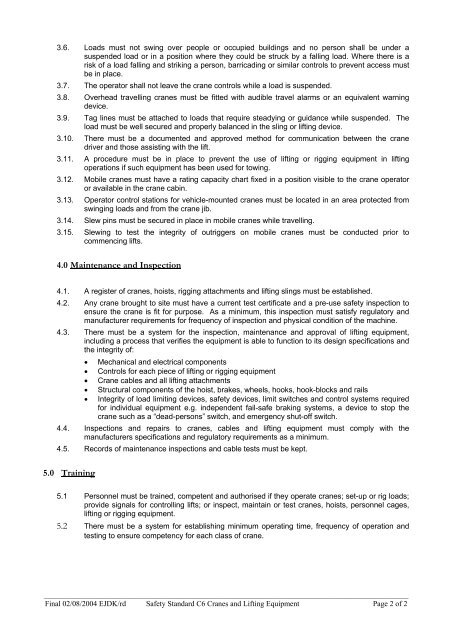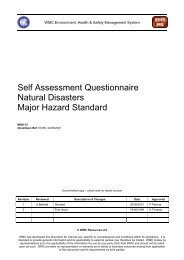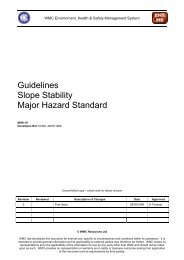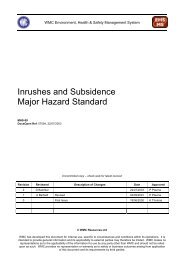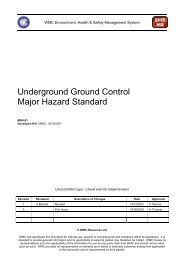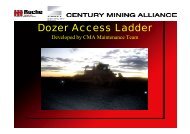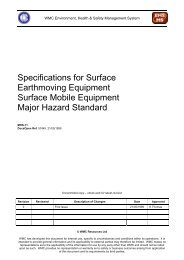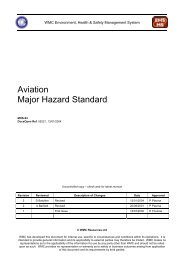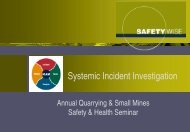RT Safety Standard C6 Cranes and Lifting Standard ... - MIRMgate
RT Safety Standard C6 Cranes and Lifting Standard ... - MIRMgate
RT Safety Standard C6 Cranes and Lifting Standard ... - MIRMgate
You also want an ePaper? Increase the reach of your titles
YUMPU automatically turns print PDFs into web optimized ePapers that Google loves.
3.6. Loads must not swing over people or occupied buildings <strong>and</strong> no person shall be under a<br />
suspended load or in a position where they could be struck by a falling load. Where there is a<br />
risk of a load falling <strong>and</strong> striking a person, barricading or similar controls to prevent access must<br />
be in place.<br />
3.7. The operator shall not leave the crane controls while a load is suspended.<br />
3.8. Overhead travelling cranes must be fitted with audible travel alarms or an equivalent warning<br />
device.<br />
3.9. Tag lines must be attached to loads that require steadying or guidance while suspended. The<br />
load must be well secured <strong>and</strong> properly balanced in the sling or lifting device.<br />
3.10. There must be a documented <strong>and</strong> approved method for communication between the crane<br />
driver <strong>and</strong> those assisting with the lift.<br />
3.11. A procedure must be in place to prevent the use of lifting or rigging equipment in lifting<br />
operations if such equipment has been used for towing.<br />
3.12. Mobile cranes must have a rating capacity chart fixed in a position visible to the crane operator<br />
or available in the crane cabin.<br />
3.13. Operator control stations for vehicle-mounted cranes must be located in an area protected from<br />
swinging loads <strong>and</strong> from the crane jib.<br />
3.14. Slew pins must be secured in place in mobile cranes while travelling.<br />
3.15. Slewing to test the integrity of outriggers on mobile cranes must be conducted prior to<br />
commencing lifts.<br />
4.0 Maintenance <strong>and</strong> Inspection<br />
4.1. A register of cranes, hoists, rigging attachments <strong>and</strong> lifting slings must be established.<br />
4.2. Any crane brought to site must have a current test certificate <strong>and</strong> a pre-use safety inspection to<br />
ensure the crane is fit for purpose. As a minimum, this inspection must satisfy regulatory <strong>and</strong><br />
manufacturer requirements for frequency of inspection <strong>and</strong> physical condition of the machine.<br />
4.3. There must be a system for the inspection, maintenance <strong>and</strong> approval of lifting equipment,<br />
including a process that verifies the equipment is able to function to its design specifications <strong>and</strong><br />
the integrity of:<br />
• Mechanical <strong>and</strong> electrical components<br />
• Controls for each piece of lifting or rigging equipment<br />
• Crane cables <strong>and</strong> all lifting attachments<br />
• Structural components of the hoist, brakes, wheels, hooks, hook-blocks <strong>and</strong> rails<br />
• Integrity of load limiting devices, safety devices, limit switches <strong>and</strong> control systems required<br />
for individual equipment e.g. independent fail-safe braking systems, a device to stop the<br />
crane such as a “dead-persons” switch, <strong>and</strong> emergency shut-off switch.<br />
4.4. Inspections <strong>and</strong> repairs to cranes, cables <strong>and</strong> lifting equipment must comply with the<br />
manufacturers specifications <strong>and</strong> regulatory requirements as a minimum.<br />
4.5. Records of maintenance inspections <strong>and</strong> cable tests must be kept.<br />
5.0 Training<br />
5.1 Personnel must be trained, competent <strong>and</strong> authorised if they operate cranes; set-up or rig loads;<br />
provide signals for controlling lifts; or inspect, maintain or test cranes, hoists, personnel cages,<br />
lifting or rigging equipment.<br />
5.2 There must be a system for establishing minimum operating time, frequency of operation <strong>and</strong><br />
testing to ensure competency for each class of crane.<br />
________________________________________________________________________________________________<br />
Final 02/08/2004 EJDK/rd <strong>Safety</strong> <strong>St<strong>and</strong>ard</strong> <strong>C6</strong> <strong>Cranes</strong> <strong>and</strong> <strong>Lifting</strong> Equipment Page 2 of 2


